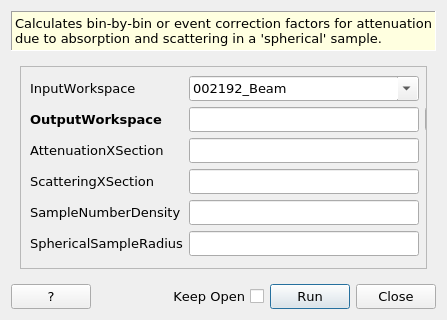\(\renewcommand\AA{\unicode{x212B}}\)
SphericalAbsorption v1¶

SphericalAbsorption dialog.¶
Summary¶
Calculates bin-by-bin or event correction factors for attenuation due to absorption and scattering in a ‘spherical’ sample.
See Also¶
Properties¶
Name |
Direction |
Type |
Default |
Description |
|---|---|---|---|---|
InputWorkspace |
Input |
Mandatory |
The X values for the input workspace must be in units of wavelength |
|
OutputWorkspace |
Output |
Mandatory |
Output workspace name |
|
AttenuationXSection |
Input |
number |
Optional |
The ‘’’absorption’’’ cross-section, at 1.8 Angstroms, for the sample material in barns, if not set with SetSampleMaterial. |
ScatteringXSection |
Input |
number |
Optional |
The (coherent + incoherent) scattering cross-section for the sample material in barns, if not set with SetSampleMaterial. |
SampleNumberDensity |
Input |
number |
Optional |
The number density of the sample in number of atoms per cubic angstrom, if not set with SetSampleMaterial |
SphericalSampleRadius |
Input |
number |
Optional |
The radius of the spherical sample in centimetresif not set with SetSample. |
Description¶
Calculates bin-by-bin or event correction factors for attenuation due to absorption and scattering in a spherical sample. Sample data should be divided by these corrections. Algorithm calls AnvredCorrection v1.
Usage¶
Example: A simple spherical sample
ws = CreateSampleWorkspace("Histogram",NumBanks=1,BankPixelWidth=1)
ws = ConvertUnits(ws,"Wavelength")
ws = Rebin(ws,Params=[1])
SetSampleMaterial(ws,ChemicalFormula="V")
#restrict the number of wavelength points to speed up the example
wsOut = SphericalAbsorption(ws,SphericalSampleRadius=0.2)
print("The created workspace has spectra: {}".format(wsOut.readY(0)))
Output:
The created workspace has spectra: [ 0.8693233 0.81842536 0.77068608 0.72590446 0.68389228 0.65847929]
Categories: AlgorithmIndex | CorrectionFunctions\AbsorptionCorrections
Source¶
C++ header: SphericalAbsorption.h
C++ source: SphericalAbsorption.cpp
